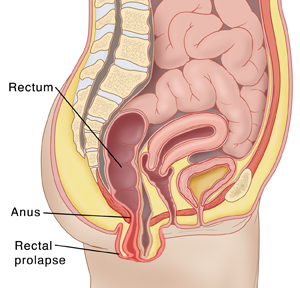Rectal Prolapse
Rectal prolapse means the rectum has fallen out of position. In many cases, rectal tissue sags out of the anus. This happens when the rectum becomes stretched out, pushes down, and sags out through the anus. A reddish mass of tissue may be seen or felt at the opening of the anus. The tissue may stick out beyond the anus. This may happen after a bowel movement and then go away for a time. Or it may be there all the time. Stool or mucus may also leak out of the anus.
Rectal prolapse happens when the structures and muscles in the pelvis and anus are weakened. It's not common. It does occur more often in older women. But it can happen in people of all ages. Pregnancy and childbirth can make it more likely. So can repeated straining to have a bowel movement.
Often people have a hemorrhoid, which they think is a prolapse. That's because they see or feel something abnormal, and many of the symptoms are the same.
The following are symptoms of a rectal prolapse:
-
Diarrhea or constipation
-
Stool leaking out
-
Mucus or blood in the stool
-
Incomplete bowel movements
-
Belly (abdominal) or rectal discomfort
Talk with your healthcare provider before trying to return the rectum back into place, by using gentle pressure. It will likely prolapse again. So for long-term treatment, you may need surgery. In some people, other organs also prolapse, such as the bladder or uterus. You'll likely be referred to a specialist who can examine you and tell you about your treatment options.

Home care
Straining during bowel movements is often a cause of prolapse. To help ease and prevent constipation, take these steps:
-
Laxatives, stool softeners, or bulking agents may be prescribed. Take these as directed. You may need them daily.
-
Add more fruits, vegetables, and whole grains to your diet. Eat less high-fat foods and processed foods such as packaged snack foods. A fiber supplement can be added if you're not getting enough fiber in your diet. The goal is 20 to 30 grams of fiber daily.
-
Don't ignore the urge to have a bowel movement. Once a day, set aside time after a meal for an undisturbed visit to the toilet.
-
Don't strain or push hard to pass stool.
-
Don't spend more than a few minutes on the toilet to have a bowel movement.
-
If you smoke, get help to quit.
If you have a prolapse, contact your healthcare provider:
To return a prolapsed rectum back into place, first wash your hands well. Wet a soft cloth with warm water. Then lie on your side with your knees to your chest. Hold the cloth to the anus and use gentle pressure to push the rectum back into place. When you’re done, call your provider. If you can't push the prolapse back or are uncomfortable doing so, call your provider. Or go to the emergency room.
Follow-up care
Follow up with your healthcare provider, or as advised. If you've been referred to a specialist, make the appointment right away.
Call 911
Call 911 if any of the following occur:
When to get medical care
Call your healthcare provider right away if any of these occur:
-
Return of the prolapse
-
Fever of 100.4°F (38°C) or higher, or as advised by your provider
-
Blood in stool
-
Belly pain or swelling
-
Repeated vomiting
-
You can't have a bowel movement or can't control bowel movements